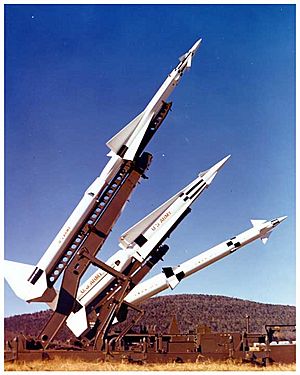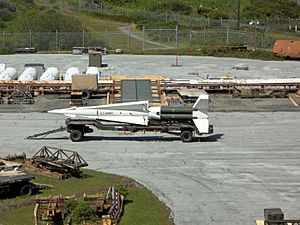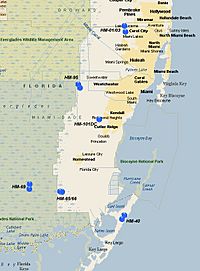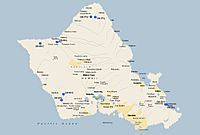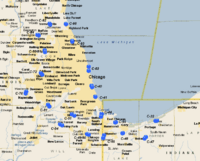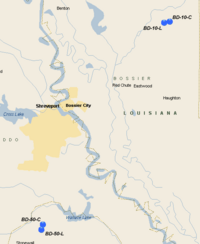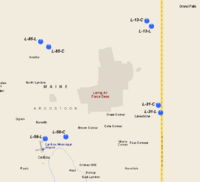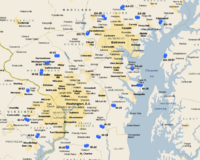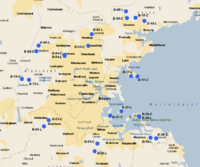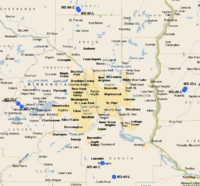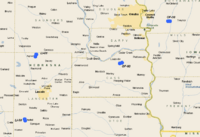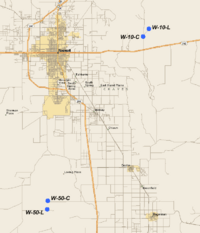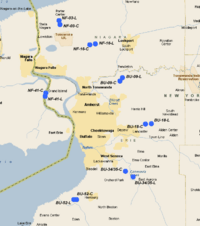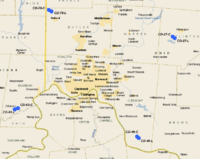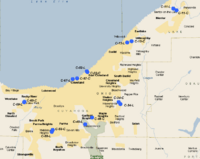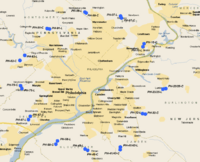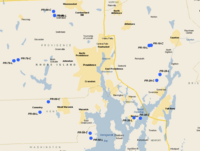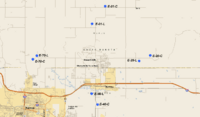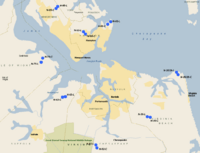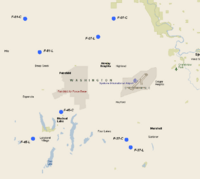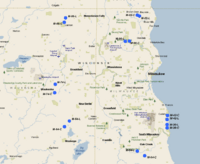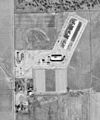List of Nike missile sites facts for kids
This article lists places where Nike missiles were kept and operated by the United States Army. Most were in the United States, but some were also sent to Europe for the NATO alliance, used by both American and European military forces. Nike sites were also in South Korea and Japan, and some were sold to Taiwan.
Today, you can still find traces of the roughly 265 Nike missile bases near cities across the United States. When these bases were no longer needed, they were often turned into new things. Many are now city parks, communication centers, or even places for games and training. A few are still mostly intact and help us remember the history of the Nike project.
Contents
- Nike Missile Sites Around the World
- Nike Missile Sites in the United States
- Alaska
- California
- Connecticut
- Florida
- Georgia
- Hawaii
- Illinois and Northwest Indiana
- Kansas
- Louisiana
- Maine
- Maryland/District of Columbia/Northern Virginia
- Massachusetts
- Michigan
- Minnesota
- Missouri
- Nebraska
- New Jersey
- New Mexico
- New York
- Ohio
- Pennsylvania
- Rhode Island
- South Dakota
- Texas
- Virginia
- Washington
- Wisconsin
- Images for kids
- See also
Nike Missile Sites Around the World
Nike missile systems were set up in many countries to protect important areas during the Cold War.
Belgium
Belgium used the Nike missile system from 1959 to 1990. Their missile sites were located in West-Germany and were meant to protect the industrial Ruhr area. These sites often had both Nike Ajax and later, more powerful Nike Hercules missiles. Some even held nuclear-armed missiles, with U.S. teams guarding them.
- Hombroich: This site, which once held 36 Nike Hercules missiles, is now a modern art museum!
Denmark
Denmark had Nike missile batteries to protect Greenland and Copenhagen.
Greenland Defense Area
Four Nike batteries were built in Greenland in 1957–1958 to defend the Thule US Airbase. Because of Greenland's cold climate, the missiles were stored underground. These sites were part of the U.S. defense system. Even though Denmark didn't want foreign military or nuclear weapons, a special agreement allowed these batteries to be nuclear-armed. Operations stopped in May 1965, but you can still see the remains of these sites.
Copenhagen Defense Area
Copenhagen was protected by four Nike batteries. They started under Army control but moved to Air Force control in 1964. They used both Nike Ajax and Hercules missiles, but later only Hercules. All Danish Nike squadrons used only conventional (non-nuclear) weapons.
- Copenhagen Sites: The main sites were Gunderød, Kongenlunden, Sigerslev, and Tune. The headquarters for the Nike Group was at the Avedøre camp.
Germany
In Germany, the 94th ADA Group had four battalions of Nike Hercules missiles. These were part of the "Nike-Belt," a defense system built to protect Europe from new jet aircraft.
- Pforzheim: This missile launch site was used by the US-Army until April 1985. It was part of the defense against potential incoming jets.
Italy
Italy's Nike units started with both Nike Ajax and Hercules missiles, but by the mid-1970s, they only used Nike Hercules. Each site with a U.S. team had 10 nuclear warheads ready to launch quickly. These sites used a mix of nuclear-capable and conventional (non-nuclear) warheads.
- Longare: An extra 60 nuclear warheads were stored here. They were ready to be flown to certain Nike sites if the world situation became dangerous. This actually happened in October 1962 during the Cuban missile crisis, when NATO went on full alert.
Japan
On Okinawa, the 30th ADA Brigade operated Nike Hercules missile sites. On May 15, 1972, these sites were given to the Japan Air Self-Defense Force (JASDF).
Norway
Norway's Nike batteries protected the capital city of Oslo, military headquarters, and airbases. They started with both Nike Ajax and Hercules missiles but later only used Nike Hercules. All Norwegian Nike missiles were armed with conventional (non-nuclear) warheads.
- Oslo Air Defense: The main sites were at Linderud (headquarters), Asker, Nes, Trogstad, and Våler.
Nike Missile Sites in the United States
In the U.S., Nike missile sites were named using a code: the Defense Area abbreviation, a two-digit number, and a letter (L for launch site, C for control site). Many sites went through the "Formerly-Used Defense Site" (FDS) program, meaning they were transferred from military control to other owners.
Alaska
Alaska's Nike sites were controlled by the United States Army Alaska (USARAK). They defended important areas like Anchorage and Fairbanks.
- Anchorage Defense Area: Sites around Anchorage protected the city, Fort Richardson, and Elmendorf AFB. One site, Point, was a dual site with two firing systems. After a big earthquake in 1964, one part was permanently out of action. The other part was the last Nike site in North America to close.
- Fairbanks Defense Area: These sites replaced older anti-aircraft guns and protected Fairbanks, Fort Wainwright, and Eielson AFB. They were closed in 1970 and 1971.
California
California had many Nike sites, especially around Los Angeles and San Francisco, due to their important aerospace industries.
- Los Angeles Defense Area (LA): Los Angeles was protected by 16 nuclear-capable sites. Many were later taken over by the California Army National Guard.
* LA-88 (Oat Mountain): This site is largely intact and abandoned. The Los Angeles Police Department (LAPD) SWAT team now uses it for training. * LA-96 (San Vicente Peak): This site has been turned into a Cold War memorial park, with some buildings and radar towers remaining.
- San Francisco Defense Area (SF): San Francisco was defended by 12 Nike sites.
* SF-88 (Fort Barry): This is the only Nike site in the country that has been preserved and is open for public tours! Volunteers and park staff have restored it to look like it did in the 1960s, complete with missiles (which are not real, of course).
Connecticut
Connecticut's Nike sites protected Bridgeport and Hartford. Many were later taken over by the National Guard.
- BR-73 (Westport): The control site still has two radar towers, one used by an observatory. The launch site is now a middle school.
- BR-94 (Shelton): The control site is now a family farm and winery! The launch site is a recreation park with baseball fields and tennis courts.
Florida
The Nike sites in Florida were especially important during the Cuban missile crisis in 1962.
- Homestead–Miami Defense Area (HM): These sites were built quickly during the Cuban Missile Crisis.
* HM-69: This site is in Everglades National Park and is largely intact. It's open to the public for tours by park staff, allowing visitors to see the administration building and launch area.
Georgia
Nike Hercules batteries in Georgia protected important Air Force bases.
- Robins AFB Defense Area (R) and Turner AFB Defense Area (TU): These sites protected B-52 bombers. They were active from 1960 to 1966. Many are now private properties or redeveloped.
Hawaii
On Oahu, four Nike Hercules batteries were built. Unlike many mainland sites, these missiles were launched from open-air pads surrounded by dirt walls.
- Oahu Defense Area (OA): These sites were active from 1961 to 1970.
Illinois and Northwest Indiana
The Chicago-Gary Defense Area was a large network of Nike sites.
- Chicago–Gary Defense Area (C): This area had many sites, some of which were later converted to Nike Hercules.
* C-47 (South Haven/Wheeler, Indiana): This site is now a paintball park called Blast Camp. The control site is abandoned but has standing buildings and radar towers. The launch site is also abandoned and deteriorating, with water in the missile magazines.
Kansas
Two Nike Hercules sites were planned for the Schilling AFB Defense Area but were never fully operational.
- Schilling AFB Defense Area (SC): Construction was abandoned in 1960, and the land was sold to private owners.
Louisiana
Two Nike Hercules sites protected Shreveport and Barksdale AFB.
- Barksdale AFB Defense Area (BD): These sites were active from 1960 to 1966.
* BD-10 (Bellevue): This site is almost completely intact and is now used by the Criminal Justice Institute and the Bossier Parish School Board. The launch site is used for SWAT field training.
Maine
Four Nike Ajax sites protected Loring Air Force Base. Some were later upgraded to Nike Hercules.
- Loring AFB Defense Area (L): These sites were active from 1957 to 1966.
* L-13 (Caswell): This site is well-preserved and privately owned, with buildings and radar towers still standing. The launch site also has visible magazines.
Maryland/District of Columbia/Northern Virginia
Many Nike installations were built in Maryland to defend Baltimore and the nation's capital. Several also were built in the northern suburbs of Virginia.
- Washington–Baltimore Defense Area (BA, W): Most of these sites remained active until 1974.
* BA-79 (Granite, Maryland): The launch site is now used by the Maryland Wing, Civil Air Patrol, and is actively being restored by volunteers. It even has both Ajax and Hercules missile elevators, which are welded shut for safety. * W-25 (Davidsonville, Maryland): This former twin-magazine site is intact and now the Anne Arundel County Police Training Academy. One of the two magazines was even converted into a gym!
Massachusetts
Boston's Nike Batteries were manned initially by Regular Army troops. In 1959, National Guard units assumed control of some sites.
- Boston Defense Area (B or BO): Some sites were upgraded to Nike Hercules missiles.
* B-73 (South Lincoln/Wayland): The control site is now the Massachusetts Audubon Society, Drumlin Farm. The launch site was removed and replaced by residential housing.
Michigan
Nike sites in Michigan protected Detroit.
- Detroit Defense Area (D): Many sites were converted from Nike Ajax to Nike Hercules.
* D-87 (Commerce/Union Lake): The control site is almost intact but abandoned and vandalized, with some fire damage. It is owned by the Michigan DNR. The launch site was demolished.
Minnesota
Four Nike Hercules batteries guarded the approaches to the Twin Cities.
- Minneapolis–St.Paul Defense Area (MS): These sites were operational from 1959 until 1971.
* MS-40 (Castle Rock): This site was once a well-preserved airsoft gaming facility. The underground missile batteries were demolished in 2001. It is now for sale and has a radio tower.
Missouri
Two Nike Hercules batteries guarded the eastern approaches to Kansas City. Other sites protected St. Louis.
- Kansas City Defense Area (KC): These sites were active from 1959 to 1969.
* KC-30 (Pleasant Hill): The launch site is intact and privately owned. The bay doors and elevators for the missiles still work and are used by the owners!
- St. Louis Defense Area (SL): These sites were active from 1960 to 1968.
Nebraska
The missiles in Nebraska provided defense for SAC B-47 bombers and Atlas missiles.
- Lincoln AFB Defense Area (LI): These sites were active between 1960 and 1966.
* LI-01 (Ceresco/Davey): The control site is now a high school. The launch site is abandoned and used as an auto junkyard, with junk cars stored in the missile firing pads.
- Offutt AFB Defense Area (OF): These sites provided Nike Hercules defense for Omaha's Offutt AFB.
New Jersey
New Jersey had several Nike sites, some of which were part of the larger New York Defense Area.
- PH23/25 (Lumberton): The control site was demolished for a housing development, but two radar towers remain on private property. The launch site's magazines are still there and are part of a municipal maintenance facility.
- NY-56 (Sandy Hook): This site is located on the former Sandy Hook Proving Ground (now part of the Gateway National Recreation Area) and has been preserved. It is open to the public for tours, and the park even has three Nike Ajax missiles and one Nike Hercules missile (inert, of course).
New Mexico
Two Nike Hercules sites were planned for Walker AFB but were never made operational.
- Walker AFB Defense Area (W): Construction was abandoned in 1960.
* W-10 (Roswell): This site is intact and used as a military academy training site.
New York
New York had one of the largest defensive networks in the nation, combined with sites in New Jersey.
- Niagara Falls–Buffalo Defense Area (NF, BU): These areas were combined in December 1961.
* BU-18 (Lancaster/Milgrove): The launch site appears in good condition, with buildings in use. The missile magazine area is used by a construction company and has working elevators!
- New York Defense Area (NY): This large network was active until 1974.
* NY-56 (Sandy Hook, New Jersey): This site is a museum and is open to the public. It's part of the Gateway National Recreation Area.
Ohio
Ohio's Nike sites protected Cincinnati, Dayton, and Cleveland.
- Cincinnati–Dayton Defense Area (CD): These sites became operational in 1960.
* CD-63 (Dillsboro, Indiana): The missile launching site was converted into a private residence, including the old missile silos!
- Cleveland Defense Area (CL): Some sites were converted to fire Nike Hercules missiles.
* CL-13 (Willowick): The magazines have a one-foot thick cap of concrete on them. The magazine area is used for school bus parking.
Pennsylvania
Pennsylvania had Nike sites protecting Philadelphia and Pittsburgh.
- Philadelphia Defense Area (PH): These sites were active from the mid-1950s.
* PH-32 (Marlton, New Jersey): This site was once a Nike Ajax base. After it closed, it became a civil defense center and later a school. The missile elevator doors were sealed with asphalt for safety.
- Pittsburgh Defense Area (PI): Operations at five of these Nike Hercules sites lasted until 1974.
* PI-37 (Cowansburg/Herminie): The site is used for light industry. Many buildings are still in use, and the magazines are still electrified and operable, used by the owner for storage.
Rhode Island
Nike sites in Rhode Island and southern Massachusetts defended Rhode Island's capital city.
- Providence Defense Area (PR): Some sites were upgraded to launch Nike Hercules missiles.
* PR-79 (Foster Center/Foster): This site is now the State of Rhode Island State Police Academy and Training Center. Its buildings are in use, and the magazines are still visible.
South Dakota
Four Nike Ajax batteries were positioned around Ellsworth AFB.
- Ellsworth AFB Defense Area (E): Most of these batteries were removed from service by 1958, with only one converted to fire Nike Hercules missiles.
* E-01 (Ellsworth AFB): The housing area next to the launch site was abandoned, and the homes were removed, leaving exposed basements. The magazine is visible but covered with vegetation and refuse.
Texas
Nike missile sites in Texas defended important Air Force bases and the Dallas/Fort Worth area.
- Bergstrom AFB Defense Area (BG): These sites protected SAC B-47 bombers and the Austin region.
* BG-80 (Austin): The control site is intact and used by the Texas Army National Guard. The launch site is now the University of Texas System Police Academy.
- Dallas–Fort Worth Defense Area (DF): These Nike Hercules sites were active from 1960 to 1968.
* DF-01 (Denton): The control site was converted into an astronomical observatory for the University of North Texas after it was decommissioned. It still has radar towers.
- Dyess AFB Defense Area (DY): These sites defended SAC bombers and Atlas F missile silos.
Virginia
Nike sites in Virginia protected the world's largest naval complex in Norfolk.
- Norfolk Defense Area (N): This area had an extensive air defense network.
* N-52 (Deep Creek/Chesapeake): The control site is now a school. The launch site is a Public Safety Training Center, with intact magazines being used as a parking lot.
Washington
Washington had Nike missile sites protecting Spokane, Hanford, and Seattle.
- Fairchild AFB Defense Area (F): These sites initially protected the Spokane region.
- Hanford Defense Area (H): Nike missiles here replaced older gun batteries and protected this nuclear industrial complex.
* H-52 (Rattlesnake Mountain): This site is intact and used as a lab for University of Washington research projects.
- Seattle Defense Area (S): This area, home to Boeing Aircraft Company, was ringed with defenses.
* S-61 (Vashon Island): This site has been turned into a public horse park named Paradise Ridge. The buildings are now used as a thrift store and a medical clinic.
Wisconsin
Milwaukee's Defense Area sites were all in Wisconsin.
- Milwaukee Defense Area (M): This area was reorganized in 1961.
* M-20 (Harbor Drive): This site is now part of the Henry Maier Festival Park. * M-74 (Waukesha): The control site still has structures in Hillcrest Park. The launch site is being redeveloped.
Images for kids
See also
- Project Nike topics
- U.S. Army Nike sites


